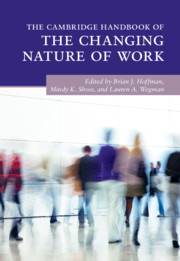Book contents
- The Cambridge Handbook of the Changing Nature of Work
- The Cambridge Handbook of the Changing Nature of Work
- Copyright page
- Contents
- Figures
- Tables
- Contributors
- Part I Introduction to the Changing Nature of Work
- Part II What Has Changed?
- 4 Changes in Technology
- 5 The Changing Nature of Work
- 6 Changes in Occupations, Jobs, and Skill Polarization
- 7 Changes in the Legal Landscape
- 8 The Rise and Decline of Organized Labor in the United States
- 9 Changes in Organizational Income Inequality
- 10 Work and Employment in Fluid Organizational Forms
- 11 Changes in Worker Demographics
- 12 Generational Changes in Personality, Values, and Abilities
- 13 Changes in Work Behavior Patterns
- Part III Implications for Talent Management and Impact on Employees
- Index
- References
8 - The Rise and Decline of Organized Labor in the United States
American Unions from Truman to Trump
from Part II - What Has Changed?
Published online by Cambridge University Press: 02 April 2020
- The Cambridge Handbook of the Changing Nature of Work
- The Cambridge Handbook of the Changing Nature of Work
- Copyright page
- Contents
- Figures
- Tables
- Contributors
- Part I Introduction to the Changing Nature of Work
- Part II What Has Changed?
- 4 Changes in Technology
- 5 The Changing Nature of Work
- 6 Changes in Occupations, Jobs, and Skill Polarization
- 7 Changes in the Legal Landscape
- 8 The Rise and Decline of Organized Labor in the United States
- 9 Changes in Organizational Income Inequality
- 10 Work and Employment in Fluid Organizational Forms
- 11 Changes in Worker Demographics
- 12 Generational Changes in Personality, Values, and Abilities
- 13 Changes in Work Behavior Patterns
- Part III Implications for Talent Management and Impact on Employees
- Index
- References
Summary
This chapter analyzes the expansion and collapse of labor union power in the United States from the postwar era to the administration of President Donald Trump. Union membership peaked in the mid-1940s and gradually declined until the early 1980s. It then slipped precipitously over that decade and in 2017 fell to levels not seen for nearly a century. Explanations for the decline include employer opposition, American social and political culture, and technological development. As union membership fell, income inequality rose. Research suggests that the economic condition of middle-class American workers is linked with union membership and collective bargaining. In 2016, white male American workers without college degrees strongly supported Donald Trump’s presidential candidacy, and his policies had a significant impact on them.
Keywords
- Type
- Chapter
- Information
- The Cambridge Handbook of the Changing Nature of Work , pp. 173 - 191Publisher: Cambridge University PressPrint publication year: 2020
References
- 1
- Cited by

